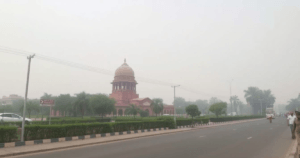Delhi-NCR Lifts GRAP-I Curbs: Major Relief as Air Quality Improves to 153
Delhi-NCR has lifted Stage I restrictions under the Graded Response Action Plan (GRAP-I) after air quality improved, with the AQI dropping to 153, categorizing it as “Moderate.” The improvement is largely attributed to recent weather changes, including a temperature drop from 40°C to 32°C and strong surface winds that helped disperse pollutants. The Commission for Air Quality Management (CAQM) and meteorological forecasts suggest that the air quality will remain stable in the coming days.
Despite lifting restrictions, authorities have urged continued pollution control efforts, particularly focusing on dust mitigation at construction sites and open areas. GRAP-I, which is enforced when AQI reaches the “Poor” range (201-300), includes restrictions on construction activities, traffic management, and industrial operations. Now that the air has cleared, these measures are no longer necessary. However, officials remain vigilant, as rising temperatures and increased dust could lead to another spike in pollution levels. Continuous monitoring and proactive measures will be key to maintaining improved air quality in the region.

Delhi-NCR Lifts GRAP-I Curbs: Major Relief as Air Quality Improves to 153
Residents of Delhi and the National Capital Region (NCR) can breathe a sigh of relief as authorities lift Stage I restrictions under the Graded Response Action Plan (GRAP) following a noticeable improvement in air quality. The decision, announced after Delhi’s Air Quality Index (AQI) dropped to 153 (classified as “Moderate”) on Saturday, reflects the positive impact of recent weather changes and pollution control efforts.
Why Were the Restrictions Lifted?
The improvement in air quality is largely attributed to shifting weather patterns. Earlier last week, Delhi experienced a scorching 40°C, but a sudden change brought cooler winds, lowering temperatures to 32°C by Friday. According to the India Meteorological Department (IMD), these winds helped disperse pollutants, clearing the haze. While temperatures are expected to stay below average for a few days, the IMD warns of a potential heat rise soon.
The Commission for Air Quality Management (CAQM), responsible for implementing GRAP, highlighted that strong surface winds and improved weather conditions played a key role in reducing pollution. Forecasts from the IMD and the Indian Institute of Tropical Meteorology (IITM) suggest that AQI will remain in the “Moderate” range (101–200) for the coming days, allowing authorities to ease restrictions.
Next Steps: Sustaining Progress
Though GRAP-I measures are no longer in effect, agencies have been instructed to continue enforcing pollution control measures. Special attention is being given to dust mitigation at construction sites, roads, and open areas, which are expected to become major pollution sources as summer approaches. Measures like water sprinkling, covering construction materials, and using anti-smog guns are being emphasized to curb dust. Authorities are also monitoring industrial emissions and waste burning to prevent a resurgence of pollution.
Understanding GRAP-I
The Graded Response Action Plan (GRAP) is a phased framework designed to combat air pollution in Delhi-NCR. It categorizes air quality into five levels based on AQI readings:
- Good (0–50)
- Satisfactory (51–100)
- Moderate (101–200)
- Poor (201–300)
- Very Poor (301–400)
GRAP-I, the first stage, is activated when the AQI enters the “Poor” category (201–300). It includes measures such as halting non-essential construction, managing traffic to reduce congestion, and restricting polluting industries. For example, traffic police may penalize idling vehicles, while construction sites must cover debris and use dust suppressants. With the AQI now in the “Moderate” zone, these measures have been paused.
Vigilance Ahead of Summer Challenges
Authorities remain cautious as Delhi transitions into warmer months when dust and industrial activity typically increase. The CAQM is closely monitoring trends and has assured residents that GRAP measures will be reinstated if air quality deteriorates. Public cooperation is also essential—citizens are urged to use public transport, avoid waste burning, and report violations like illegal construction or industrial emissions.
Conclusion
While the lifting of GRAP-I offers temporary relief, long-term air quality improvements depend on sustained efforts. Weather conditions provided a natural assist, but consistent enforcement of regulations and public participation are crucial for maintaining cleaner air. As temperatures rise, proactive measures and community awareness will be key to preventing Delhi-NCR’s air quality from slipping back into hazardous zones.
You must be logged in to post a comment.